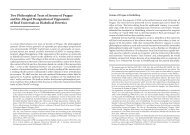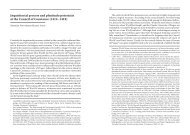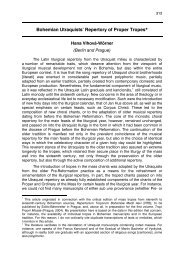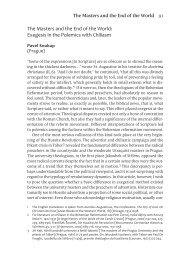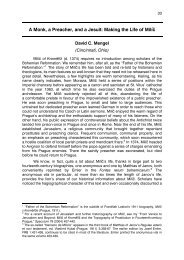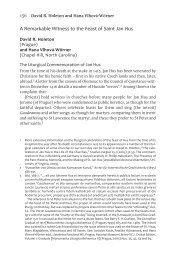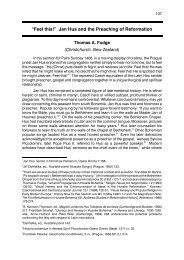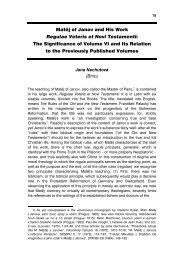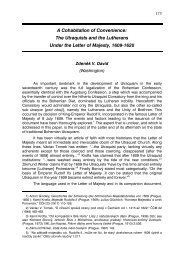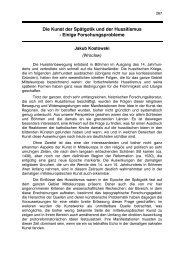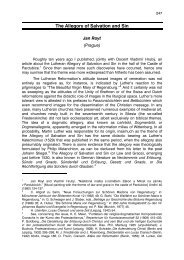quod mulieres, que sunt in Christo, in hoc - Bohemian Reformation ...
quod mulieres, que sunt in Christo, in hoc - Bohemian Reformation ...
quod mulieres, que sunt in Christo, in hoc - Bohemian Reformation ...
You also want an ePaper? Increase the reach of your titles
YUMPU automatically turns print PDFs into web optimized ePapers that Google loves.
86<br />
prostitutes, and the erection of a sanctuary for them, called Jerusalem. 26 Of course,<br />
his natural sympathy and magnanimity also played a role. 27 In the case of Milíč this<br />
possibility can not be ruled out, firmly anchored as he was <strong>in</strong> the medieval<br />
Weltanschauung. His rehabilitation of prostitutes and protection of penitent women 28<br />
performed <strong>in</strong> a different manner the same function as Jan Želivský’s subse<strong>que</strong>nt<br />
destruction of brothels. Both represented a liquidation of the houses of prostitution,<br />
although <strong>in</strong> different ways. In fact, Milíč, properly speak<strong>in</strong>g, applied the second<br />
method as well when he caused a demolition of the bordello, known as “Benátky”<br />
[Venice]. 29 Just as Jesus had freed Mary Magdalene from the power of the seven<br />
demons, Milíč extracted the prostitutes from diabolical clutches. He then took good<br />
care of the penitent women, who surrounded him, and – like Mary Magdelene <strong>in</strong> the<br />
case of Jesus – accompanied him <strong>in</strong> his later life, until his departure for Avignon. As if<br />
to underl<strong>in</strong>e the connection, he had a chapel erected <strong>in</strong> honor of Mary Magdalene. A<br />
comb<strong>in</strong>ation of the holy woman’s evangelical message with his struggle aga<strong>in</strong>st the<br />
Antichrist helped to expla<strong>in</strong> the apparent contradiction between his misogynist<br />
theories and the morbid detachment <strong>in</strong> his personal contact with women, on the one<br />
hand, and his devoted daily care for the penitent prostitutes, on the other.<br />
Beside Mary Magdalene, Milíč showed a fervent devotion to the Virg<strong>in</strong> Mary,<br />
not only accord<strong>in</strong>g to contemporary conventions, but also as an expression of his<br />
own <strong>in</strong>nermost conviction. He repeatedly cited the angelic greet<strong>in</strong>g “Ave Maria” <strong>in</strong> his<br />
synodal sermons. 30 The feast day of Mary’s birth occupied a special place among his<br />
Sunday and holiday sermons. 31 At his bidd<strong>in</strong>g, the prayer “Hail Holy Queen”<br />
resounded as an expression of Marian veneration after Friday sermons at the<br />
Jerusalem foundation. 32<br />
Return<strong>in</strong>g to the earlier-mentioned views of Matěj of Janov concern<strong>in</strong>g<br />
women’s grow<strong>in</strong>g piety, it was evident that this biblical scholar did not regard women<br />
as creatures of a lower order than men but, to the contrary, <strong>in</strong> certa<strong>in</strong> respects valued<br />
them more highly. In disregard of gender, he posited the rules [regulae] for the<br />
differentiation between the true and the false Christians. The former, who <strong>in</strong>cluded<br />
women as well as men, were to be admitted to fre<strong>que</strong>nt communion without any<br />
restriction. Janov used as the fundamental source and model for his gender-bl<strong>in</strong>d<br />
stance the theological lore of Scripture, 33 and disregarded those church doctors and<br />
other authorities who – appeal<strong>in</strong>g to St. Paul – had promoted a strongly misogynist<br />
l<strong>in</strong>e of thought. 34 Largely freed from this dependence, he arrived <strong>in</strong> his speculation<br />
about true Christians to such a favorable female image that he excelled over other<br />
ecclesiastical authorities labour<strong>in</strong>g toward a more pro-fem<strong>in</strong><strong>in</strong>e po<strong>in</strong>t of view. The<br />
latter pioneers, more often philosophers than theologians, grounded their optimistic<br />
views <strong>in</strong> the veneration of Mary, and postulated an antithesis between the s<strong>in</strong>ful Eve<br />
26<br />
“Život Milíče z Kroměříže,” 418 ff. For a survey of literature on this subject see also Božena<br />
Kopičková, “Žena a rod<strong>in</strong>a v husitství,” HT 12 (1999) 40.<br />
27<br />
For a testimony of admiration see Matěj z Janova, “Matěje z Janova Zpráva o Milíčovi z Kroměříže,”<br />
FRB I:431-436; concern<strong>in</strong>g Milíč’s <strong>in</strong>fluence on Janov see, for <strong>in</strong>stance, Kybal, Matěj z Janova 22.<br />
28<br />
Výbor z české literatury doby husitské 1:49.<br />
29<br />
Kolářová-Císařová, Žena v hnutí husitském 33.<br />
30<br />
Herold and Mráz, eds., Jana Milíče z Kroměříže Tři řeči synodní 75, 105.<br />
31<br />
František M. Bartoš, Dvě studie o husitských postilách 6.<br />
32<br />
Kolářová-Císařová, Žena v hnutí husitském 34.<br />
33<br />
Kybal, Matěj z Janova 33 ff.<br />
34<br />
Ibid. 47.



